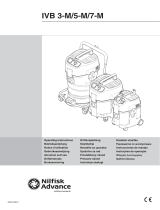- 20 -
` Channel A/B Timing Settings
This sub-menu provides memory timing settings for each channel of memory. The respective timing setting
screens are congurable only when DRAM Timing Selectable is set to Quick or Expert.Note: Your system
may become unstable or fail to boot after you make changes on the memory timings. If this occurs, please reset
the board to default values by loading optimized defaults or clearing the CMOS values.
` Advanced Voltage Settings
This sub-menu allows you to set CPU, chipset and memory voltages.
& Channel Interleaving
Enables or disables memory channel interleaving. Enabled allows the system to simultaneously access
different channels of the memory to increase memory performance and stability. (Default: Enabled)
& Rank Interleaving
Enables or disables memory rank interleaving. Enabled allows the system to simultaneously access different
ranks of the memory to increase memory performance and stability. (Default: Enabled)
& DRAM Timing Selectable
Quick and Expert allows the memory timing settings below to be congurable. Options are: Auto (default),
Quick, Expert.
& ProleDDRVoltage
When using a non-XMP memory module or ExtremeMemoryProle(X.M.P.) is set to Disabled, this item
will display as 1.50V. When ExtremeMemoryProle(X.M.P.) is set to Prole1 or Prole2, this item will
display the value based on the SPD data on the XMP memory.
& ProleVTTVoltage
The value displayed here is dependent on the CPU being used.
` PC Health Status
& ResetCaseOpenStatus
Disabled Keeps or clears the record of previous chassis intrusion status. (Default)
Enabled Clears the record of previous chassis intrusion status and the CaseOpen eld will
show "No" at next boot.
& CaseOpen
Displays the detection status of the chassis intrusion detection device attached to the motherboard CI
header. If the system chassis cover is removed, this eld will show "Yes", otherwise it will show "No". To
clear the chassis intrusion status record, set ResetCaseOpenStatus to Enabled, save the settings to
the CMOS, and then restart your system.
& CPU Vcore/DRAM Voltage/+3.3V/+5V/+12V
Displays the current system voltages.
& CPU/System Temperature
Displays current CPU/system temperature.
& CPU/System Fan Speed
Displays current CPU/system fan speeds.
& CPU Warning Temperature
Sets the warning threshold for CPU temperature. When CPU temperature exceeds the threshold, BIOS
will emit warning sound. Options are: Disabled (default), 60
o
C/140
o
F, 70
o
C/158
o
F, 80
o
C/176
o
F, 90
o
C/194
o
F.
& CPU/System Fan Fail Warning
Allows the system to emit warning sound if the fan is not connected or fails.Check the fan condition or fan
connection when this occurs. (Default: Disabled)
& CPU Fan Speed Control
Allows you to determine whether to enable the CPU fan speed control function and adjust the fan speed.
Normal Allows the CPU fan to run at different speeds according to the CPU temperature. You can
adjust the fan speed with EasyTune based on your system requirements. (Default)




















